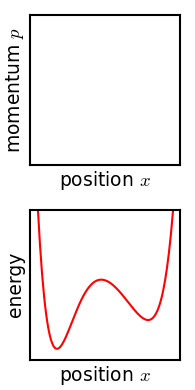
Ergodic theory
Ergodic theory is a branch of mathematics that studies statistical properties of deterministic dynamical systems; it is the study of ergodicity. In this context, "statistical properties" refers to properties which are expressed through the behavior of time averages of various functions along trajectories of dynamical systems. The notion of deterministic dynamical systems assumes that the equations determining the dynamics do not contain any random perturbations, noise, etc. Thus, the statistics with which we are concerned are properties of the dynamics.
Ergodic theory, like probability theory, is based on general notions of measure theory. Its initial development was motivated by problems of statistical physics.
A central concern of ergodic theory is the behavior of a dynamical system when it is allowed to run for a long time. The first result in this direction is the Poincaré recurrence theorem, which claims that almost all points in any subset of the phase space eventually revisit the set. Systems for which the Poincaré recurrence theorem holds are conservative systems; thus all ergodic systems are conservative.
More precise information is provided by various ergodic theorems which assert that, under certain conditions, the time average of a function along the trajectories exists almost everywhere and is related to the space average. Two of the most important theorems are those of Birkhoff (1931) and von Neumann which assert the existence of a time average along each trajectory. For the special class of ergodic systems, this time average is the same for almost all initial points: statistically speaking, the system that evolves for a long time "forgets" its initial state. Stronger properties, such as mixing and equidistribution, have also been extensively studied.
The problem of metric classification of systems is another important part of the abstract ergodic theory. An outstanding role in ergodic theory and its applications to stochastic processes is played by the various notions of entropy for dynamical systems.
The concepts of ergodicity and the ergodic hypothesis are central to applications of ergodic theory. The underlying idea is that for certain systems the time average of their properties is equal to the average over the entire space. Applications of ergodic theory to other parts of mathematics usually involve establishing ergodicity properties for systems of special kind. In geometry, methods of ergodic theory have been used to study the geodesic flow on Riemannian manifolds, starting with the results of Eberhard Hopf for Riemann surfaces of negative curvature. Markov chains form a common context for applications in probability theory. Ergodic theory has fruitful connections with harmonic analysis, Lie theory (representation theory, lattices in algebraic groups), and number theory (the theory of diophantine approximations, L-functions).
Convergence of the ergodic means in the Lp norms[edit]
Let (X, Σ, μ) be as above a probability space with a measure preserving transformation T, and let 1 ≤ p ≤ ∞. The conditional expectation with respect to the sub-σ-algebra ΣT of the T-invariant sets is a linear projector ET of norm 1 of the Banach space Lp(X, Σ, μ) onto its closed subspace Lp(X, ΣT, μ). The latter may also be characterized as the space of all T-invariant Lp-functions on X. The ergodic means, as linear operators on Lp(X, Σ, μ) also have unit operator norm; and, as a simple consequence of the Birkhoff–Khinchin theorem, converge to the projector ET in the strong operator topology of Lp if 1 ≤ p ≤ ∞, and in the weak operator topology if p = ∞. More is true if 1 < p ≤ ∞ then the Wiener–Yoshida–Kakutani ergodic dominated convergence theorem states that the ergodic means of ƒ ∈ Lp are dominated in Lp; however, if ƒ ∈ L1, the ergodic means may fail to be equidominated in Lp. Finally, if ƒ is assumed to be in the Zygmund class, that is |ƒ| log+(|ƒ|) is integrable, then the ergodic means are even dominated in L1.
Ergodic flows on manifolds[edit]
The ergodicity of the geodesic flow on compact Riemann surfaces of variable negative curvature and on compact manifolds of constant negative curvature of any dimension was proved by Eberhard Hopf in 1939, although special cases had been studied earlier: see for example, Hadamard's billiards (1898) and Artin billiard (1924). The relation between geodesic flows on Riemann surfaces and one-parameter subgroups on SL(2, R) was described in 1952 by S. V. Fomin and I. M. Gelfand. The article on Anosov flows provides an example of ergodic flows on SL(2, R) and on Riemann surfaces of negative curvature. Much of the development described there generalizes to hyperbolic manifolds, since they can be viewed as quotients of the hyperbolic space by the action of a lattice in the semisimple Lie group SO(n,1). Ergodicity of the geodesic flow on Riemannian symmetric spaces was demonstrated by F. I. Mautner in 1957. In 1967 D. V. Anosov and Ya. G. Sinai proved ergodicity of the geodesic flow on compact manifolds of variable negative sectional curvature. A simple criterion for the ergodicity of a homogeneous flow on a homogeneous space of a semisimple Lie group was given by Calvin C. Moore in 1966. Many of the theorems and results from this area of study are typical of rigidity theory.
In the 1930s G. A. Hedlund proved that the horocycle flow on a compact hyperbolic surface is minimal and ergodic. Unique ergodicity of the flow was established by Hillel Furstenberg in 1972. Ratner's theorems provide a major generalization of ergodicity for unipotent flows on the homogeneous spaces of the form Γ \ G, where G is a Lie group and Γ is a lattice in G.
In the last 20 years, there have been many works trying to find a measure-classification theorem similar to Ratner's theorems but for diagonalizable actions, motivated by conjectures of Furstenberg and Margulis. An important partial result (solving those conjectures with an extra assumption of positive entropy) was proved by Elon Lindenstrauss, and he was awarded the Fields medal in 2010 for this result.